Published Studies

The Potential of High-Throughput DNA Sequencing of the Paranasal Sinus Microbiome in Diagnosing Odontogenic Sinusitis
Otolaryngol Head Neck Surg. 2019;161(6):1043-1047.
Study: A case series with chart review of 142 patients with sinusitis was performed within a single tertiary care academic medical center. The study objective was to evaluate the use of high-throughput DNA sequencing to diagnose sinusitis of odontogenic origin. The patient’s computed tomography sinus scan was used as a reference standard. In those patients having an odontogenic source based on computed tomography, high-throughput sequencing produced sensitivity and specificity values of greater than 80% in the detection of oral flora species in the sinus. This study supports the use of high-throughput DNA sequencing in supplementing other methods of investigation for identifying an odontogenic etiology of sinusitis. Read Study

The Role of Bacterial Biofilms and the Pathophysiology of Chronic Rhinosinusitis
Current allergy and asthma reports
Research Article: The earliest description of a bacterial biofilm is likely centuries old. However, only in the past few decades has a wealth of knowledge developed pertaining to this bacterial form of existence. Biofilms have been implicated mainly in chronic disease states, and the current available treatment modalities for infection have demonstrated limited efficacy against bacteria in this form. Read Article

Determining the Utility of Standard Hospital Microbiology Testing: Comparing Standard Microbiology Cultures With DNA Sequence Analysis in Patients With Chronic Sinusitis
World J Otorhinolaryngol Head Neck Surg. 2019;5(2):82-87.
Study: In a prospective cohort study, 50 chronic sinusitis patients underwent standard hospital cultures (SHC) and DNA sequence analysis as a means to identify polymicrobial pathogens. DNA sequence analysis detected 31.9% more microorganisms compared to SHC (P < 0.05). When multiple microorganisms were detected, DNA sequence analysis yielded more positive results compared to SHC (P < 0.05). Culture failed to identify the dominant species in the microbiome 53% of the time; 20% of the patients had anaerobic bacteria detected by DNA analysis missed by SHC. Antimicrobial therapy based on culture results would have been adequate for only 44% of the patients, compared to 74% based on DNA results. In patients with recalcitrant sinus disease, conventional cultures may need to be augmented with or replaced by molecular-based probes. Read Study

Analysis of Sinonasal Microbiota in Exacerbations of Chronic Rhinosinusitis Subgroups
OTO Open. 2019;3(3):2473974X19875100.
Retrospective Study: In a retrospective review of 134 chronic rhinosinusitis patients, a DNA microbiome analysis was performed in an effort to identify any similarities or differences in clinical subgroups (65 had nasal polyps, 14 had allergic fungal rhinosinusitis, and 55 had neither). Between 1 and 11 taxa were observed in taxa with >2% relative abundance. Samples from nasal polyp patients and allergic fungal rhinosinusitis patients had an increased prevalence of S aureus. Otherwise, bacterial richness was remarkably low in all samples. Read Study

Use of Dipstick Assay and Rapid PCR-DNA Analysis of Nasal Secretions for Diagnosis of Bacterial Sinusitis in Children With Chronic Cough
Allergy Rhinol (Providence). 2019;10:2152656718821281.
Study:Twenty-two patients under the age of 15 with chronic cough were assessed with use of nasal dipstick sample acquisition and polymerase chain reaction (PCR)-DNA analysis in an effort to differentiate bacterial sinusitis from other causes of chronic cough and to identify pathogens from the nasal cavity. Potential dominant pathological bacteria were identified in 80% of the children with chronic cough and sinusitis. DNA analysis was an effective tool in identifying relevant pathogens and directing specific therapies. It can be considered as an alternative to imaging studies for sinusitis diagnosis. Read Study

Sinus Culture Poorly predicts Resident Microbiota
Int Forum Allergy Rhinol. 2015;5(1):3-9.
Research Study: In a prospective case series, samples from 54 chronic rhinosinusitis patients, collected after surgery, were analyzed by both clinical culture and 16S ribosomal RNA (rRNA) gene sequencing. The accuracy of clinical culture compared to DNA-based molecular techniques was assessed. Each subject had an average of 3 isolates identified by culture and 21.5 ± 12.5 species identified by 16S sequencing. Dominant taxa (>10% abundance) detected via sequencing were detected with culture less than 50% of the time. Only 29.5% of the cultured isolates represented the dominant species. Read Study
